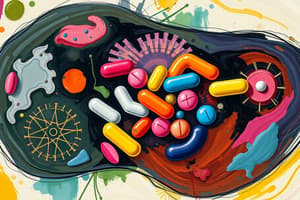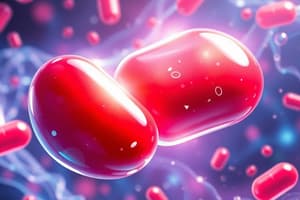Podcast
Questions and Answers
What is the primary mechanism by which Niacin influences lipid levels?
What is the primary mechanism by which Niacin influences lipid levels?
- By decreasing LPL activity
- By directly inhibiting the synthesis of cholesterol in the liver
- By inhibiting both fatty acid synthesis and reducing the transport of free fatty acids to the liver
- By reducing hepatic triglyceride synthesis and increasing LPL activity (correct)
A patient reports experiencing flushing and mild nausea after starting a new medication. Which lipid-modifying agent is most likely responsible for these ADR?
A patient reports experiencing flushing and mild nausea after starting a new medication. Which lipid-modifying agent is most likely responsible for these ADR?
- Omega-3 fatty acid ethyl esters
- An LDL reductase inhibitor
- Niacin (correct)
- A resin
Which of the following is a potential drug-drug interaction of omega-3 fatty acid ethyl esters?
Which of the following is a potential drug-drug interaction of omega-3 fatty acid ethyl esters?
- Reduced efficacy when taken with other lipid-lowering agents
- Increased risk of bleeding in patients taking anticoagulants (correct)
- Increased risk of hepatotoxicity with reductase inhibitors
- Increased risk of myopathy when taken with a resin
What is the primary effect on triglyceride levels when administering omega-3 fatty acid ethyl esters?
What is the primary effect on triglyceride levels when administering omega-3 fatty acid ethyl esters?
The half-life of Niacin is described as:
The half-life of Niacin is described as:
Which of the following best describes the primary mechanism of action for HMG-CoA reductase inhibitors?
Which of the following best describes the primary mechanism of action for HMG-CoA reductase inhibitors?
A patient is prescribed a statin medication. Which of the following adverse reactions is most concerning and requires careful monitoring?
A patient is prescribed a statin medication. Which of the following adverse reactions is most concerning and requires careful monitoring?
Which of the following statin medications is primarily metabolized through glucuronidation?
Which of the following statin medications is primarily metabolized through glucuronidation?
How do bile acid binding resins impact liver function?
How do bile acid binding resins impact liver function?
Which characteristic is commonly associated with bile acid binding resins?
Which characteristic is commonly associated with bile acid binding resins?
What is the primary mechanism of action of fibrate medications?
What is the primary mechanism of action of fibrate medications?
Which of the following best describes the primary mechanism of action of fibrates?
Which of the following best describes the primary mechanism of action of fibrates?
Which medication would require dose adjustment if prescribed alongside atorvastatin due to potential drug-drug interactions?
Which medication would require dose adjustment if prescribed alongside atorvastatin due to potential drug-drug interactions?
Which of these statins should be taken in the evening (PM)?
Which of these statins should be taken in the evening (PM)?
A patient is taking gemfibrozil. Which of the following is a significant risk associated with this medication, compared to fenofibrate?
A patient is taking gemfibrozil. Which of the following is a significant risk associated with this medication, compared to fenofibrate?
What is the primary mechanism of action of ezetimibe in reducing cholesterol?
What is the primary mechanism of action of ezetimibe in reducing cholesterol?
Which of the following medications is a PCSK9 inhibitor?
Which of the following medications is a PCSK9 inhibitor?
What is a significant contraindication for the use of PCSK9 inhibitors like evolocumab and alirocumab?
What is a significant contraindication for the use of PCSK9 inhibitors like evolocumab and alirocumab?
Which of the following best describes a key pharmacokinetic characteristic of fibrates?
Which of the following best describes a key pharmacokinetic characteristic of fibrates?
What is the interaction between ezetimibe and statins when used together?
What is the interaction between ezetimibe and statins when used together?
Which of the following is a potential drug-drug interaction that can increase the risk of myopathy?
Which of the following is a potential drug-drug interaction that can increase the risk of myopathy?
Flashcards
HMG-CoA Reductase Inhibitors (Statins)
HMG-CoA Reductase Inhibitors (Statins)
A class of drugs that inhibit the enzyme HMG-CoA reductase, which is involved in cholesterol synthesis. This leads to a decrease in LDL cholesterol levels in the blood.
How do Statins work?
How do Statins work?
Statins are competitive inhibitors of the enzyme HMG-CoA reductase, meaning they bind to the active site and block the enzyme's function.
How are Statins metabolized?
How are Statins metabolized?
Statins are primarily metabolized by the liver, with most metabolites being excreted in the feces and urine.
Bile Acid Sequestrants
Bile Acid Sequestrants
Signup and view all the flashcards
Fibrates
Fibrates
Signup and view all the flashcards
What are the effects of Fibrates on lipid metabolism?
What are the effects of Fibrates on lipid metabolism?
Signup and view all the flashcards
How do Fibrates work?
How do Fibrates work?
Signup and view all the flashcards
What are Fibrates used for?
What are Fibrates used for?
Signup and view all the flashcards
Sterol Absorption Inhibitors
Sterol Absorption Inhibitors
Signup and view all the flashcards
PCSK9 Inhibitors
PCSK9 Inhibitors
Signup and view all the flashcards
Myopathy
Myopathy
Signup and view all the flashcards
Niacin (Nicotinic Acid)
Niacin (Nicotinic Acid)
Signup and view all the flashcards
Statins
Statins
Signup and view all the flashcards
Synergistic Effect
Synergistic Effect
Signup and view all the flashcards
Extrinsic vs. Intrinsic
Extrinsic vs. Intrinsic
Signup and view all the flashcards
How does Niacin increase HDL levels?
How does Niacin increase HDL levels?
Signup and view all the flashcards
What are some side effects of Niacin?
What are some side effects of Niacin?
Signup and view all the flashcards
How do Omega-3 fatty acids affect triglyceride levels?
How do Omega-3 fatty acids affect triglyceride levels?
Signup and view all the flashcards
What are Omega-3 fatty acids used for?
What are Omega-3 fatty acids used for?
Signup and view all the flashcards
What are some side effects of omega-3 fatty acids?
What are some side effects of omega-3 fatty acids?
Signup and view all the flashcards
Study Notes
HMG-CoA Reductase Inhibitors (Statins)
- Statins are oral medications used to lower cholesterol levels
- They work by inhibiting HMG-CoA reductase, a key enzyme in cholesterol synthesis
- Atorvastatin, Fluvastatin, Rosuvastatin, Lovastatin, Simvastatin, Pitavastatin, and Pravastatin are examples of statins.
- Some statins are prodrugs, meaning they are inactive until metabolized in the body
- Active forms of statins are inhibitors, meaning they block the production of cholesterol
- Statins increase LDL receptors in the liver, effectively removing LDL cholesterol from the blood.
- Statins are generally well-tolerated but should be avoided by those with certain conditions like pregnancy, liver disease, and heavy alcohol consumption.
Drug Interactions
- Statins can interact with other medications.
- Grapefruit juice can inhibit the metabolism of some statins, potentially increasing their levels in the blood.
- Some statins should not be taken with fibrates (Gemfibrozil).
- Certain azoles or macrolides should be used cautiously with statins
Bile Acid Binding Resins
- These resins are used to lower cholesterol levels by binding bile acids in the intestine, preventing their reabsorption and stimulating the liver to produce more bile acids from cholesterol.
- Examples include Colestipol and Cholestyramine.
- These medications may cause gastrointestinal discomfort, such as heartburn, diarrhea, and bloating.
- They should be taken before meals.
- Interaction with fat soluble vitamins such as vitamin K may be reduced.
Fibrates
- Fibrates (e.g., Gemfibrozil, Fenofibrate) are used to lower triglycerides and raise HDL cholesterol.
- They work by activating PPAR-α receptors, which affect lipid metabolism.
- These drugs may cause myopathy and interact with other drugs.
- Fenofibrate is usually better tolerated compared to gemfibrozil.
Sterol Absorption Inhibitors
- These drugs (e.g., Ezetimibe) work by inhibiting the absorption of cholesterol from the intestines.
- They are often used in combination with statins for a more significant reduction in LDL cholesterol.
PCSK9 Inhibitors (Monoclonal Antibodies)
- These are used to lower LDL cholesterol by reducing LDL receptor degradation.
- They are given via injection (subcutaneous).
- Examples include Evolocumab (brand name Repatha) and Alirocumab (brand name Praluent).
- They are used to treat high cholesterol, especially in patients with a severe form of hypercholesterolemia, those with an inadequate response to other lipid-lowering agents, or with other factors such as diabetes that might increase risk of cardiovascular events
Niacin (Nicotinic Acid)
- A vitamin that can also lower cholesterol levels.
- It reduces the production of VLDL and increases HDL levels, effectively improving lipid profile.
- Common side effects include flushing, and should be administered carefully with patient monitoring.
Fish Oil (Omega-3 Fatty Acids)
- Primarily used to reduce triglycerides.
- May improve blood lipid profile, in particular, lowering triglycerides.
- May cause side effects like increased bleeding and should be used with caution by patients taking blood thinners.
Studying That Suits You
Use AI to generate personalized quizzes and flashcards to suit your learning preferences.



